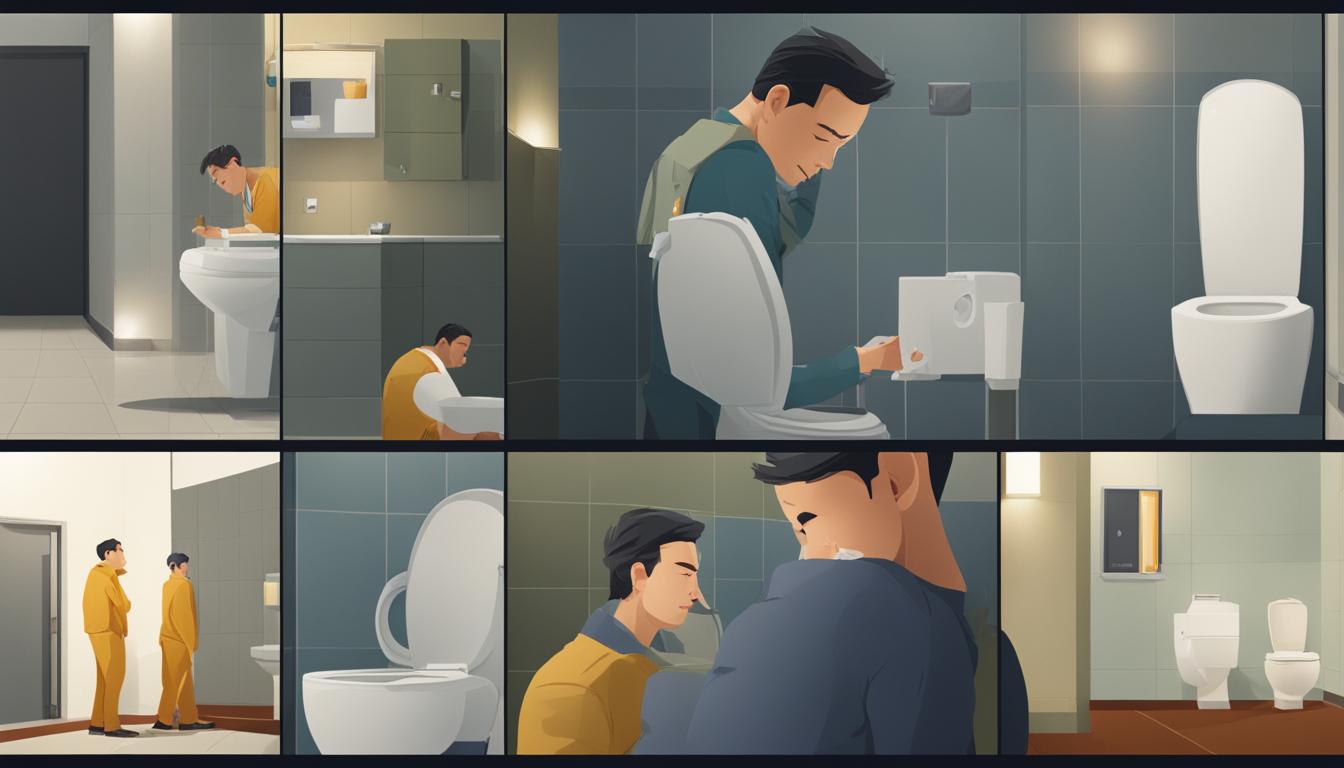Enlarged prostate, also known as benign prostatic hyperplasia (BPH), can lead to urinary problems and affect prostate health. Recognizing the warning signs of an enlarged prostate early is crucial for proactive management and the prevention of future urinary issues. Here are five warning signs to watch out for:
Key Takeaways:
- Recognizing the warning signs of an enlarged prostate is essential for proactive management.
- Early detection of symptoms can help prevent future urinary issues.
- Enlarged prostate symptoms may include frequent urination, weak urine flow, and difficulty emptying the bladder completely.
- Other possible symptoms include blood in the urine and urinary tract infections.
- Consulting a medical professional is crucial for accurate diagnosis and appropriate treatment options.
Risk Factors for Prostate Cancer
While an enlarged prostate is not necessarily indicative of prostate cancer, understanding the risk factors associated with this disease is crucial for prostate health management. Certain factors can increase a man’s likelihood of developing prostate cancer, including age, race and ethnicity, and family history.
Age
Age is a significant risk factor for prostate cancer. The likelihood of developing this disease increases with age, particularly after the age of 50. It is important for men to be aware of the increasing risk as they get older and to prioritize regular prostate health screenings.
Race and Ethnicity
Race and ethnicity also play a role in prostate cancer risk. African American men have a higher incidence of prostate cancer compared to men of other ethnic backgrounds. Additionally, African American men are more likely to be diagnosed at an advanced stage and have a higher mortality rate from the disease. Understanding these disparities can help inform targeted prevention and screening efforts within specific populations.
Family History
A family history of prostate cancer can significantly increase an individual’s risk. If a man has a close relative, such as a father or brother, who has had prostate cancer, his own risk is higher. Genetic factors may play a role in this increased risk. It is essential to be aware of family history and discuss it with healthcare professionals to determine appropriate screening and prevention strategies.
By understanding these risk factors, individuals can take proactive measures to prioritize their prostate health. Regular screenings and discussions with healthcare professionals can help detect prostate cancer early, leading to better treatment outcomes.
| Risk Factors | Description |
|---|---|
| Age | The risk increases with age, particularly after the age of 50. |
| Race and Ethnicity | African American men have a higher incidence and mortality rate from prostate cancer. |
| Family History | Having a close relative with prostate cancer increases the risk. |
Other Conditions with Similar Symptoms
While an enlarged prostate can cause noticeable symptoms, several other conditions can also lead to similar signs and symptoms. It’s crucial to be aware of these conditions to accurately determine the cause of specific symptoms and seek appropriate treatment. Here are some conditions that share similar signs and symptoms:
1. Benign Prostatic Hyperplasia (BPH)
BPH, also known as prostate gland enlargement, is a common condition that affects many men as they age. It occurs when the prostate gland grows bigger and begins to press against the urethra, causing urinary symptoms. The symptoms of BPH can closely resemble those of an enlarged prostate, including:
- Increased frequency of urination
- Weak urine flow
- Incomplete emptying of the bladder
- Urinary urgency
2. Prostatitis
Prostatitis is the inflammation of the prostate gland and can occur in men of all ages. It can lead to symptoms similar to those of an enlarged prostate, such as:
- Pain or burning sensation during urination
- Frequent urination
- Urinary urgency
- Difficulty urinating
3. Urinary Tract Infections (UTIs)
Urinary tract infections can affect various parts of the urinary system, including the prostate. When the prostate becomes infected, it can cause symptoms similar to those of an enlarged prostate, such as:
- Pain or burning sensation during urination
- Increased frequency of urination
- Urgency to urinate
- Cloudy or bloody urine
4. Kidney Stones
Kidney stones are hard deposits that form in the kidneys and can cause significant discomfort. When a kidney stone moves into the urinary tract, it can cause symptoms similar to those of an enlarged prostate, including:
- Severe pain in the back, side, or lower abdomen
- Blood in the urine
- Urinary urgency
- Frequent urination
It’s important to note that these conditions may require different treatments and management approaches. If you experience any symptoms related to an enlarged prostate or similar conditions, it is essential to consult a healthcare professional for an accurate diagnosis and treatment plan.

Prostate Cancer Symptoms and Diagnosis
Prostate cancer, one of the most common cancers in men, often develops without noticeable symptoms in its early stages. However, as the cancer progresses, certain symptoms may arise, indicating the need for prompt medical attention.
If you experience any of the following symptoms, it is crucial to consult a healthcare professional for further evaluation:
- Frequent urination: Problems with urination, such as the need to urinate more often, especially during the night, can be a potential symptom of prostate cancer.
- Weak urine flow: Finding it difficult to start or maintain a steady urine stream may be an indication of prostate issues, including prostate cancer.
- Blood in urine: The presence of blood in the urine, known as hematuria, can be a warning sign of various urinary tract problems, including prostate cancer.
It’s important to note that these symptoms can also be indicative of other non-cancerous conditions, such as urinary tract infections or benign prostatic hyperplasia (BPH). Therefore, a proper diagnosis is essential to determine the underlying cause.
Diagnosing prostate cancer typically involves a series of tests and evaluations, including:
- Prostate-specific antigen (PSA) test: This blood test measures the levels of PSA, a protein produced by the prostate. Elevated PSA levels may indicate the presence of prostate cancer.
- Digital rectal examination (DRE): During this physical examination, a healthcare provider assesses the size, shape, and texture of the prostate gland by inserting a gloved, lubricated finger into the rectum.
- Biopsy: If abnormalities are detected during the PSA test or DRE, a biopsy may be recommended to collect tissue samples from the prostate for further analysis.
Early detection and proper diagnosis play a crucial role in improving treatment outcomes for prostate cancer. Regularly monitoring for symptoms and seeking medical attention can help ensure timely intervention and appropriate management of the condition.
Treating Prostate Cancer
The treatment approach for prostate cancer may vary depending on factors such as cancer stage, grade, and overall health. Treatment options may include:
“The right treatment plan for prostate cancer is determined after considering various factors, including the cancer’s stage and grade, as well as the patient’s overall health and personal goals. Treatment options may include active surveillance, surgery, radiation therapy, hormone therapy, or chemotherapy.”
Working closely with a team of medical professionals, including urologists, oncologists, and radiation specialists, is essential to develop an individualized treatment plan tailored to each patient’s specific needs.

Taking Action for Prostate Health
Prostate health is an essential aspect of overall well-being for men. By taking proactive steps, we can effectively manage symptoms, detect potential issues early, explore treatment options, and consult with medical professionals for expert guidance.
Managing symptoms is a key part of maintaining prostate health. By paying attention to changes in urinary patterns, such as increased frequency or weak urine flow, we can identify potential problems and take appropriate action. It’s important not to ignore symptoms like blood in the urine, as these could be signs of underlying issues that require medical attention.
Early detection is crucial when it comes to the prostate. Regular screenings, such as prostate-specific antigen (PSA) tests, can help identify potential problems before they progress. These screenings can also aid in the early detection of prostate cancer, providing more treatment options and a better chance of successful outcomes.
When it comes to treatment options, consulting with medical professionals is vital. They can guide us through the various options available and help us make informed decisions based on our unique circumstances. Whether it’s medication, lifestyle changes, or surgical interventions, medical professionals can provide the necessary expertise to navigate the journey towards better prostate health.
FAQ
What are the warning signs of an enlarged prostate?
The warning signs of an enlarged prostate include frequent urination, weak urine flow, difficulty starting and stopping urination, dribbling urine, and nocturia.
What are the risk factors for prostate cancer?
The risk factors for prostate cancer include age (above 50), race and ethnicity (African-American men are at higher risk), and a family history of prostate cancer.
What other conditions have similar symptoms to an enlarged prostate?
Other conditions with similar symptoms to an enlarged prostate include benign prostatic hyperplasia (BPH), prostatitis, urinary tract infections, and kidney stones.
What are the symptoms of prostate cancer and how is it diagnosed?
Symptoms of prostate cancer can include frequent urination, weak urine flow, blood in urine, and pain or discomfort in the pelvic area. Prostate cancer can be diagnosed through a combination of physical exams, blood tests, and biopsies.
How can I take action for prostate health?
To prioritize prostate health, you can manage symptoms through lifestyle changes, undergo regular screenings, explore treatment options, and consult with medical professionals.
What Are the Warning Signs of Enlarged Prostate Complications?
Some warning signs of complications of enlarged prostate include frequent urges to urinate, difficulty starting or maintaining a steady stream of urine, weak urine flow, incomplete bladder emptying, and urinary retention. Other signs may include blood in the urine, urinary tract infections, and bladder stones.



